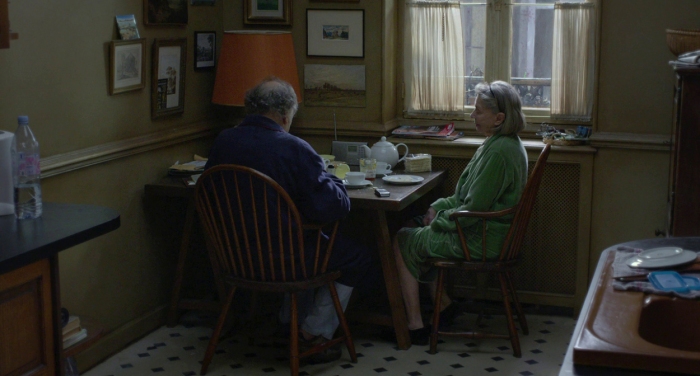
Honesty is a rare quality in films these days. But every once in a while, a film comes along that presents an honest view of the world, a pure slice of reality, without trying to manipulate the viewer’s feelings. Amour by Michael Haneke is one such film. The premise is quite simple: An elderly, cultured, middle class couple live their life quietly, doing the things they enjoy: attending piano concerts, reading, listening to music. Then one day, the woman suffers a mild stroke. And then another. Her condition gradually deteriorates. Her husband is left to care for her and witness the transformation of his beloved partner from an intelligent human being to a vegetable.
While it is sometimes uncomfortable to watch, it is ultimately a profoundly moving film. Its emotional impact starts with the casting; the mere fact that 2 giants of French cinema like Emmanuelle Riva and Jean-Louis Trintignant, have in their 80s agreed to be a part of this undignified journey of physical disintegration, is by itself quite touching. Actors, even octogenarians, tend to be image-conscious, and it is hard to imagine any actor who would willingly tarnish their image this way in the twilight of their career. Their performances are among the finest I have ever seen in a film.
I could go on about the qualities of this film; the clear-headed, unbiased direction by Haneke, the restrained cinematography (by non-other than Darius Khondji of Seven and Panic Room), but what really stands out for me is the production design by Jean-Vincent Puzos. Set entirely in one apartment (with the exception of one scene at the beginning) it is a lesson in carefully personalised set dressing, thoughtful texturing and ageing of surfaces, and an ingenious layout that both drives and enhances the emotional journey of the characters.

Built entirely on a soundstage, this is a typical Parisian apartment with big windows and parquet flooring – which apparently was made from old wooden blocks to get the right creaking sound when actors walk on it. It features an unusually big hallway (adorned by a large Aubusson wall tapestry), which works as the nerve centre of the house; around it all the rooms are circularly laid out and the lives of the characters revolve. The size of this hallway gives the characters long walking distances between rooms, emphasising their increasing difficulty to move independently. It also provides stunning long shots through doors, sometimes looking at 2 rooms at the same time. Doors are a powerful symbol in the film, representing the stages of life and the passing from one stage to the next. It is no coincidence that in the final shot of the film, after the inevitable end, all the doors are open in the empty house for the first time, allowing the couple’s daughter to walk freely between rooms.

By contrast, we find that the rest of the rooms are modestly sized. The kitchen, which is where the elderly couple spend a lot of their time is a small, intimate space, just big enough to fit a small table and 2 chairs. It is in this small room that Anne has her first stroke. The tired Windsor chairs, the condensation-stained walls and greasy wall tiles, all echo a long life of companionship that is now coming to an end.
The rest of the rooms are equally evocative of the life the couple has lived; the study, with the baby grand piano, the wooden panelled walls and the record collection, is testament to their affiliation with music. The walls are lined with pictures and paintings. There is a sequence where Haneke shows us in full close up 6 different paintings hanging in different places around the house, all in the style of classic French landscape paintings of the mid-19th century. They are the only images of nature in the entire film, and they offer the audience a much needed respite after one of the most intense scenes of the film.

There is nothing flashy, or even impressive in the design of Amour. It is after all just an architectural space filled with a selection of props. The difference is that these mostly old things (with the exception of a modern CD player) look like they truly belong in this particular place. All things, bid and small, look like they have been slowly and lovingly collected throughout many years of coexistence, and represent a lifetime of experiences, tastes and feelings. They are personal belongings that signify everything that these people are, and everything that they are about to lose. I believe this to be the highest achievement of a production designer, to create a set that reflects the characters with no frills, no cheap sentimentality, with an honesty that ultimately shows life as it is; wonderful, tragic, real.